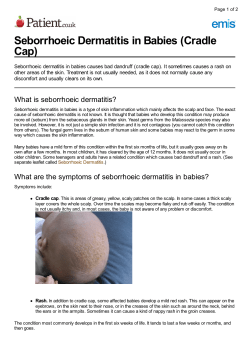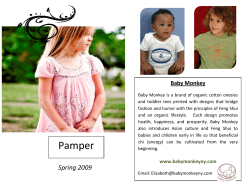
Cradle cap
Cradle cap Cradle cap is a common type of dermatitis that forms a scaly crust of skin on a baby's scalp. • • Symptoms include greasy, yellowish, crusty scales on the scalp. Cradle cap usually disappears by itself but treatments are generally aimed at softening the crust so that it can be removed more easily. What it is Cradle cap is a temporary and harmless skin condition that affects the scalp of young babies. It causes yellowish, greasy and scaly patches on the scalp but doesn't usually cause any discomfort to the baby. This form of dermatitis (seborrhoeic dermatitis) usually begins in the first few months of a baby's life and is rare in babies over a year old. It is very common, affecting almost half of all babies and severe cases are rare. The condition is not contagious, nor serious and most cases clear up without intervention after the baby is a few months old. Cradle cap is caused by overactive sebaceous glands that produce an excess of the oily substance sebum, which waterproofs the skin. This causes shed skin cells to stick to the scalp rather than drying up and falling off as they normally would. Cradle cap tends to appear in babies who have a family history of allergies such as eczema and asthma. Symptoms include yellowish, patchy, scaly, greasy and crusty skin on the scalp and redness appearing on the affected area. Occasionally there is hair loss in the affected area. Who it affects Cradle cap usually appears in the first two months of a baby's life and rarely continues after the age of one, although in rare cases it may persists beyond three years. Children with cradle cap are more likely to develop eczema in later years. How to treat it Cradle cap usually settles over time with no particular treatment but many parents prefer to remove the scales. A common suggested treatment is to massage baby oil into the scalp then letting it absorb overnight. The next morning the scales may be removed with very gentle massaging with a soft cloth or soft toothbrush before washing the scalp with a gentle baby shampoo. It may take several days using this treatment for the scales to completely disappear and cradle cap may reappear since the glands will still make too much sebum for several weeks. In some cases the skin under the crust of cradle cap can be infected with the same bacteria that causes impetigo or 'school sores'. The skin will become red, small blisters will appear and they may pop and weep. If the infection spreads your baby may become unwell a doctor may have to prescribe antibiotics to clear the infection or suggest an antifungal cream or shampoo. Inflamed rashes may be treated with a mild steroid cream.
© Copyright 2025





















